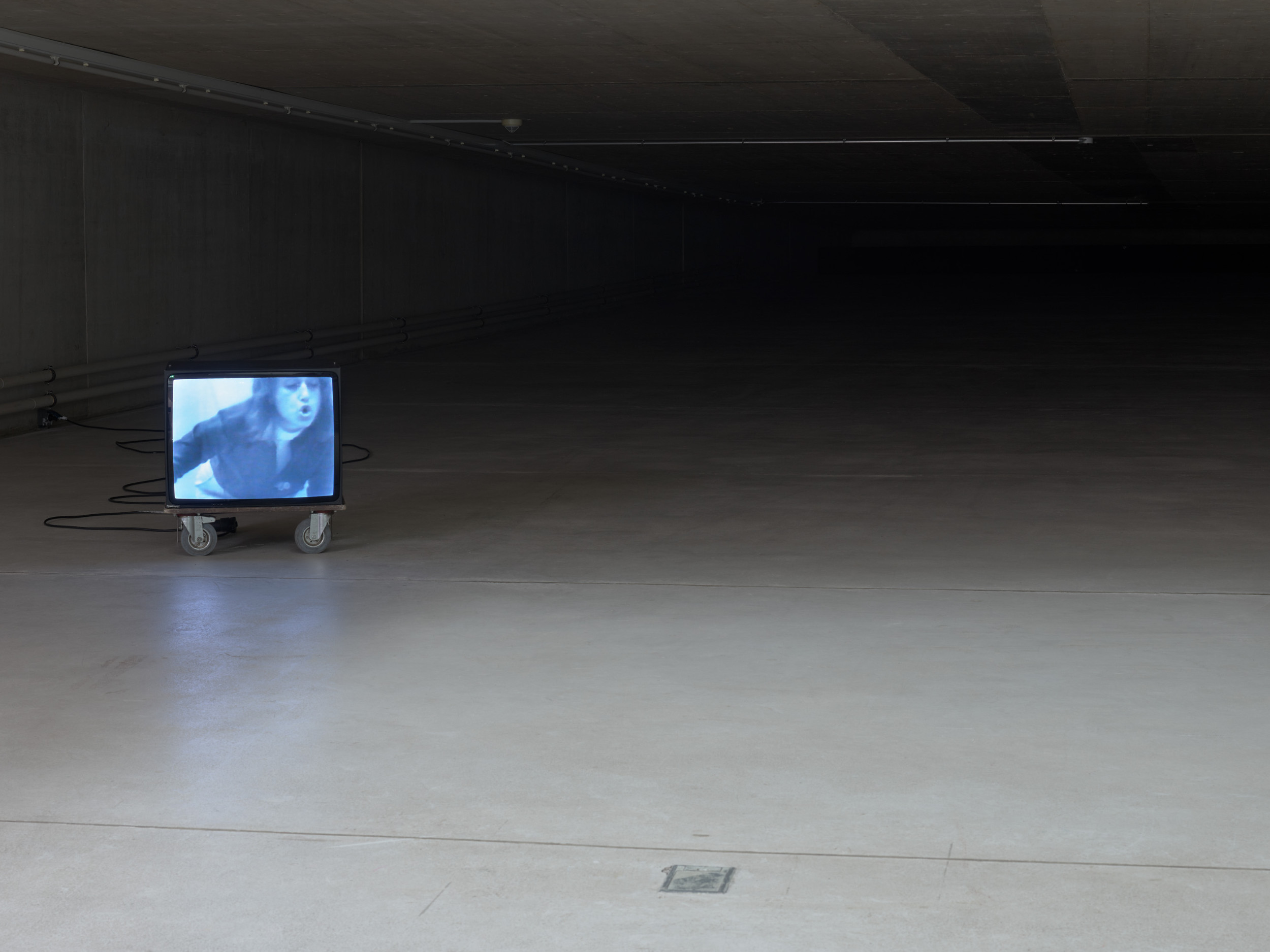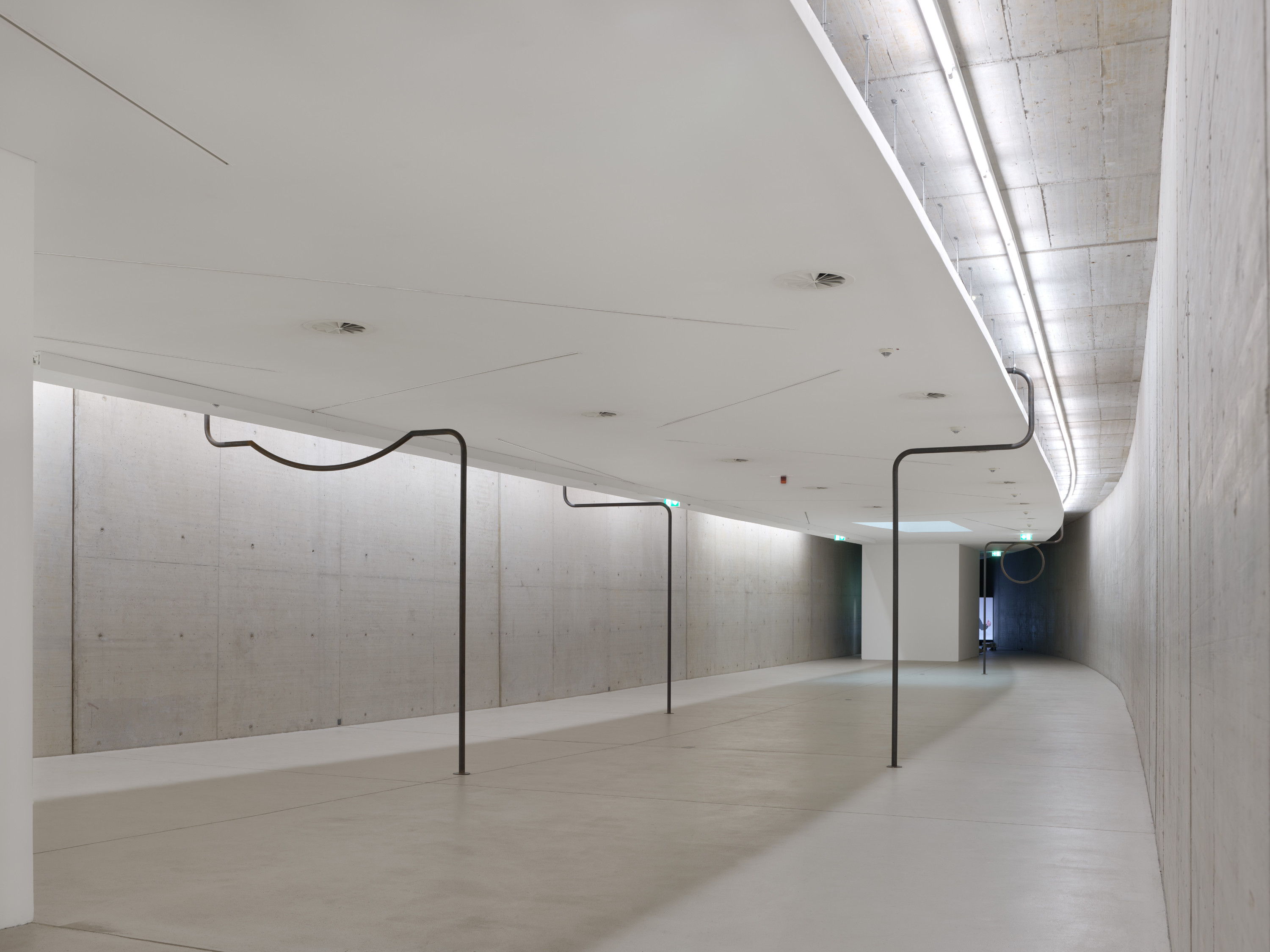Simnikiwe Buhlungu long time lung time continuuum!!! (a conver-something)
Kunst im Tunnel, Düsseldorf
24 February – 20 May, 202415-04-2024
I’m half-writing this piece from a former nunnery in rural France. There’s a buzzing cohort of artists and writers in the building (>50 but <100, I’d estimate), solitude is scarce, and it’s been nearly a month since I saw the exhibition “long time lung time continuuum!!! (a conver-something),” an initiative by artist Simnikiwe Buhlungu featuring VALIE EXPORT and Pamela Z. When I was there in the show I thought, “I could really write about this,” and that remains true, but the feeling in your body that is thinking and the extension of that feeling into text run through different circuits—and I haven’t had much access to the latter in recent months. Two years of tinnitus and chronic inner ear pain have taxed my capacity for composition. Not that it’s been all staring at the blank page—I edited a text here and there, cast some resin, got offered a job making molds for film props that probably pays better than my teaching position—but writing (as opposed to feeling↔thinking) has been slow. I actually had to leave the nunnery; it was too quiet and paradoxically contained too many voices for my misfiring little nervous system.

“long time lung time” also has a lot of voices: the press release cites two institutions, the exhibition space Kunst im Tunnel (KIT) and the video archive Inter Media Art Institute (IMAI); three artists; a synthesizer and a ventilation system. This polyvocal quality is characteristic of the practice of Simnikiwe Buhlungu, who coined the term conver-something to describe these assemblages of spaces, systems, tools, artists, visitors, etc. The space of KIT is idiosyncratic. As the name suggests, the gallery is situated underground, in the space formed between traffic tunnels that run below the eastern bank of the Rhine in Düsseldorf’s Altstadt. The space itself is shaped like the hull of a large ship, its two ends tapering up into shadowy recesses. At one end of the show is a video by VALIE EXPORT on a small monitor sitting just at the threshold between the lit interior and the space’s darkened extremity. In Breath Text: Love Poem (1970–1973), EXPORT forcefully inhales and exhales on a pane of glass placed just in front of the camera, building an ephemeral layer of condensation. The video is just over two minutes, but it really goes to my head, by which I mean, I imagine the hyper-ventilation required for this performance left EXPORT over-oxygenated and slightly intoxicated. You can have all the feels of a love poem without the sonnet structure because it is not the words (left unformed in the breath or unwritten on the glass) but respiration itself that gets you high.
On the far side of the gallery sits a projected video of the vocalist, composer and author Pamela Z performing Breathing (2014) from her Carbon Song Cycle. Z breathes into a microphone, laying down a sonic foundation upon which she slowly builds with loops, samples, singing and speaking. On the back of her hand is a device, which she uses to manipulate the various tracks, causing them to stutter, glitch and loop with each gesture. In her text “A Tool is a Tool,”¹ Pamela Z positions herself in a line of experimental vocalists, including Joan La Barbara, whose Voice is the Original Instrument (1976) proposed what could be done vocally with a minimum of melody or language. It is very hard to vocalize without slipping into some kind of tonal or semiotic pattern, and maybe that’s why that record always struck me as a brilliant kind of ending: it can only move inwards towards the multiplicities contained inside the voice. Unlike the La Barbara of Voice, Pamela Z doesn’t withdraw from singing and speaking, but she delays them both in that first layering of breaths; and rather than moving inward into her voice, she extends it outward through digital prosthetics, pressing the loop machine into service as an external lung.

Lungs, as the title suggests, is one way of connecting the works throughout the exhibition. The space itself, wedged between the traffic tunnels that comprise Germany’s Federal Highway 1, could be considered a kind of lung, as it inhales commuters and exhales CO2. Simnikiwe Buhlungu’s sculptural intervention in the belly of the space emphasizes this respiratory function, given that it is a group of four floor-to-ceiling pipes modeled after those in KIT’s ventilation system. A tiny stream of air emits from a small hole in each pipe, a subtle but effective gesture that I imagine you’d only notice if you put your ear up to the hole, and instead of hearing a sound found a gentle blowing. Buhlungu’s other intervention in the space is a sound work made with a Roland Juno-6 synthesizer. The show’s press release elevates the relation between artist and instrument to a collaboration, suggesting the mutual use that device and operator put each other to. “long time lung time” is really a sound-heavy show, which for me is always equally about the conditions of listening as it is about producing sound. Perhaps this entails being specific about the “hardware” of the listener, rather than taking for granted a homogeneous experience of hearing. Buhlungu’s exhibition attends not only to the instruments and tools we use, but also to the devices that we are. If the voice is the original instrument, then the ear is the original synthesizer, converting between electrical signals and analog sound waves; and if one’s hardware is busted (as mine is), the more like a collaboration between autonomous (and possibly unhappy) partners it becomes.
Now back home in Amsterdam, I look up Breath Text on the internet to refresh my memory. The only version I can find is a short sample on Pierre Bal-Blanc’s TikTok account. Bal-Blanc took an iPhone video of EXPORT’s film as it plays on his MacBook Air. Some guy on Letterboxd describes the resulting clip as an “absolutely terrible version.” I suppose I agree—the effect of the window within a window within a window is a little creepy. I feel self-conscious watching someone watching someone breathe. I leave the tab open as I navigate away to write, but the video has a tendency to start playing on its own, so my typing is punctuated every so often by EXPORT’s heavy respiration. Perhaps my browser wants its own contributor byline. Or maybe this was not all for attribution, it’s just my problem, and now I’m making it this exhibition’s problem. There is of course no one body that can adequately convey the phenomenological experience of a show, only partial ones attempting an impossible but necessary task. Without experience, however ontologically or affectively variegated the body having it might be, we’d be left with only discourse. Although it is a conver-something, rather than language, “long time lung time” foregrounds the holes, surfaces and circuits in which it sings, toots, blows, etc., all that gives breath its shape and direction. This is not a traditional phenomenology, as Buhlungu’s intervention extends “the body” into the exhibition’s (infra)structures. Honestly, I got more TLC from the noise musician playing in the nunnery’s basement than from my ENT (thanks for nothing Dr. Derks), so I’m down for giving up that tired abstraction, “the body,” for something where the prosthetic’s strap is harder to (conceptually) unfasten.
- In Women, Art, and Technology, Judy Malloy ed. Cambridge, MA: MIT Press, 2003: 348-361.